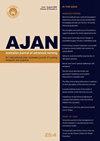Inpatient falls prevention: state-wide survey to identify variability in Western Australian hospitals
IF 1.3
4区 医学
Q3 NURSING
引用次数: 0
Abstract
Objective: A point prevalence survey was conducted across Western Australia to monitor adherence to evidence-based practices to prevent falls in hospitals. Study design and methods: A state-wide point prevalence survey of patients and their medical records was conducted across 20 hospitals, over 17 days during May 2014. The survey determined rates of: provision of verbal information to patients; completion of a falls risk screening tool and age based cognitive testing. Univariate and multivariate logistic regression was utilised to determine key risks and opportunities to improve. Results: Information was collected from 2,720 patients. The provision of verbal information to prevent falls, as recalled by patients was 60% (hospital range 35–88%). This was significantly higher for patients with a stay of six or more days or involved in rehabilitation care. Perinatal women were three times less likely to be provided with verbal falls prevention information. A falls risk screening tool was completed for 82% of patients (range 28–98%). Perinatal women, and both adult and paediatric patients compared to older adults, were significantly less likely to have a complete falls risk screening tool. Thirty seven percent of patients within the recommended age ranges had cognitive testing (range 0–87%). Short-term patients and those not involved in rehabilitation, were significantly less likely to have been tested. Discussion: The survey identified differences in patient care and supporting processes across all hospitals. The results have highlighted areas for improvement. Conclusion: There were wide variations across all the hospitals in the provision of falls information, completion of falls risk screening tools and cognitive testing. At significant risk of missing out on falls prevention strategies were short stay patients and perinatal women. Five hospitals had significantly low rates of cognitive testing, indicating a hospitalwide issue rather than specific patient cohorts. Subsequently, the importance of ensuring that falls prevention strategies are conducted is vital to reduce preventable inpatient falls in all care settings. Implications for research, policy and practice: This was the first state-wide point prevalence study in WA and it has informed the need for further research into the implication of falls risk inpatients. It was found that falls risk assessment was not conducted for each patient who met the screening criteria. A review of the criteria, and practicability to carry out the assessment may need to be further investigated to determine if the practice should be refined. What is already known about the topic? Falls in hospitals are a frequent and largely considered preventable health concern. Falls that occur in hospitals are associated with an increased length of stay and use of health resources. What this paper adds: This paper offers a comprehensive insight into the variation in hospital falls prevention strategies, from a state-wide perspective. It also identifies perinatal women as a high-risk group who are missing out on falls prevention strategies despite having the potential to fall. It also gives an insight to health services that not all at risk patients are being screened and those screened are not screened early in their inpatient stay which can be a risk to both patient and staff.住院病人跌倒预防:全州范围内的调查,以确定在西澳大利亚州医院的可变性
目的:在西澳大利亚州进行了一项点患病率调查,以监测医院对循证实践的依从性,以防止跌倒。研究设计和方法:2014年5月,在全州20家医院对患者及其医疗记录进行了为期17天的点状患病率调查。调查确定了以下比率:向患者提供口头信息;完成跌倒风险筛查工具和基于年龄的认知测试。单变量和多变量逻辑回归用于确定关键风险和改进机会。结果:收集了2720例患者的信息。根据患者的回忆,提供口头信息以防止跌倒的比例为60%(医院范围为35-88%)。对于住院6天或更长时间或参与康复护理的患者,这一比例明显更高。围产期妇女获得口头预防跌倒信息的可能性要低三倍。82%的患者(范围28-98%)完成了跌倒风险筛查工具。围产期妇女、成人和儿科患者与老年人相比,拥有完整的跌倒风险筛查工具的可能性明显较低。在推荐的年龄范围内,37%的患者进行了认知测试(范围0-87%)。短期患者和未参与康复治疗的患者接受检测的可能性明显较低。讨论:调查确定了所有医院在患者护理和支持流程方面的差异。调查结果突出了有待改进的领域。结论:所有医院在提供跌倒信息、完成跌倒风险筛查工具和认知测试方面存在很大差异。短期住院患者和围产期妇女有很大的风险错过预防跌倒的策略。五家医院的认知测试率明显较低,这表明这是整个医院的问题,而不是特定的患者群体。因此,确保实施预防跌倒战略对于减少所有护理环境中可预防的住院跌倒至关重要。对研究、政策和实践的影响:这是西澳第一个全州范围内的点患病率研究,它告知需要进一步研究住院患者跌倒风险的影响。研究发现,并没有对每一位符合筛查标准的患者进行跌倒风险评估。对准则的审查和进行评估的可行性可能需要进一步调查,以确定是否应该改进这种做法。关于这个话题我们已经知道了什么?在医院摔倒是一种常见的、在很大程度上被认为是可预防的健康问题。在医院发生的跌倒与住院时间的延长和卫生资源的使用有关。本文补充的内容:本文提供了一个全面的洞察医院跌倒预防策略的变化,从全国范围内的角度来看。它还确定围产期妇女是一个高风险群体,尽管她们有摔倒的可能,但却错过了预防跌倒的策略。它还使卫生服务部门了解到,并非所有有风险的患者都得到了筛查,而那些接受筛查的患者在住院期间没有得到早期筛查,这可能对患者和工作人员都构成风险。
本文章由计算机程序翻译,如有差异,请以英文原文为准。
求助全文
约1分钟内获得全文
求助全文
来源期刊
CiteScore
2.30
自引率
7.10%
发文量
27
审稿时长
>12 weeks
期刊介绍:
The Australian Journal of Advanced Nursing publishes a wide variety of original research, review articles, practice guidelines, and commentary relevant to nursing and midwifery practice, health- maternity- and aged- care delivery, public health, healthcare policy and funding, nursing and midwifery education, regulation, management, economics, ethics, and research methodology. Further, the journal publishes personal narratives that convey the art and spirit of nursing and midwifery.
As the official peer-reviewed journal of the ANMF, AJAN is dedicated to publishing and showcasing scholarly material of principal relevance to national nursing and midwifery professional, clinical, research, education, management, and policy audiences. Beyond AJAN’s primarily national focus, manuscripts with regional and international scope are also welcome where their contribution to knowledge and debate on key issues for nursing, midwifery, and healthcare more broadly are significant.

 求助内容:
求助内容: 应助结果提醒方式:
应助结果提醒方式:


